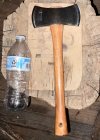- Joined
- Mar 8, 2008
- Messages
- 26,170
I think it's very noticeable.
The 6" I added makes a huge difference , and the 1lb double bit hatchet is drastically smaller and lighter to carry than the stock CT saddle axe.
There's clearly a good reason why DB hatchets have pretty much always been properly small.
I honestly when it comes to use and practicality, I'd probably much rather have the CT that I hung as a small cruiser than the 1lb DB hatchet.
The DB hatchets or " saddle cruisers " are definitely cool and they are useful, but a single bit hatchet is the standard for good reason.
Note that I didn't say it wasn't noticeable -- I said that the difference in head weight/size doesn't make a major functional difference for most circumstances. That is to say, in any circumstance where you had equal handle length, having one head vs the other wouldn't have a huge impact on whether or not you were able to effectively accomplish the job in front of you. That there are circumstances where there are efficiency gains, but few where there's a true application suitability difference where one works and the other does not. There is so much functional overlap between the two heads that when all else is held equal there are mostly only efficiency gains from one vs. the other that are determined by specific context of use and they may be used interchangeably of one another.



